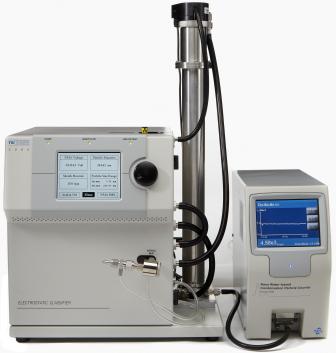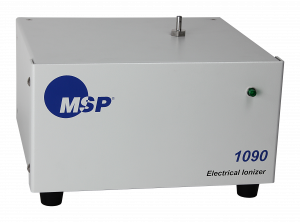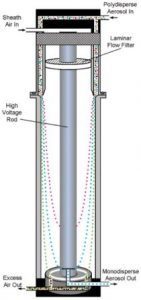Instrument Support Level 3
TSI Inc,. 3082 (units 1, 2 and 3)
ncas-smps-1, ncas-smps-2, ncas-smps-3
aerosol-size-distribution
£75,000
5.7 cm × 41.4 cm × 40.6 cm ,17.6 kg
See page for details
£30
Calendar

Scanning Mobility Particle Sizer
The 3082 SMPS is widely used as the standard for measuring airborne particle size distributions and can measure from 2.5 – 1000nm (depending on the configuration). This system is also routinely used to generate monodisperse nanoparticle for characterising other instrumentation. The National Institute of Standards and Technology (NIST) uses a TSI DMA to size 60nm and 100 nm standard size reference materials. SMPS spectrometer sizing is a discreet technique in which number concentrations are measured directly without assuming the shape of the particle size distribution. The SMPS reports what is termed the mobility diameter and has a high degree of absolute sizing accuracy and measurement repeatability.
Important
The SMPS unit operates with a sealed radioactive source, known as the neutraliser. The source is Kr-85, a beta emitter. Two sources are available, one with an activity of 74MBeq and the other 370MBeq. The University of Manchester has a mobile license and can operate it around the country. However, all users who require the use of the SMPS must have their own site licence to house this source and have spare capacity on the licence. If this source is to be used away from the host institute, then users must have a mobile licence, with capacity for the source. Before any loan of the AMOF SMPS is agreed, the users must supply proof of the licence and the spare capacity to the IS and a copy of the local rules for handling and storage of Radioactive substances for approval by University of Manchester local Radiological Protection Officer.
An alternative to the radioactive source, the MSP 1090, is a recently purchased electrical ioniser. This does not produce any ionising radiation and works on corona discharge. The unit requires some maintenance and is less suited for particles <10nm. Please contact the IS for details.

There are two identical 3082 units available, with long DMA (13 – 1000nm) and nano DMA (2.5-160nm). These instruments also require a dedicated particle counter.
Scanning Mobility Particle Sizer Spectrometer (SMPS) measures the size distribution and concentration of particles in the size range of 2 nm to 1 μm using differential mobility analysis. This method is based on the physical principle that the ability of a particle to traverse an electric field (electrical mobility) is fundamentally related to particle size—no size calibration is necessary (first principle measurement). In a Differential Mobility Analyzer (DMA), an electric field is created and the airborne particles drift in the dma according to their electrical mobility. Particle size is then calculated from the mobility distribution. This method is independent of the particle zeta potential.

Sizing limitations of surface techniques include low sample sizes (non-representative), image edge definition problems, 3d to 2d image distortion, and operator bias. Rigorous peer reviewed uncertainty analysis has been performed indicating the DMA has a sizing uncertainty of approximately 3 – 3.5%.

The instrument is serviced annually by the manufacturer if the instrument has been used extensively. This includes checking the flow rate, optics alignment and replacing filters and tubing
It should be noted that there is no absolute calibration standard for particle number concentration. The sizing and counting efficiency is checked using PSL spheres and a reference counter.
A basic service check will be performed on the unit before it is shipped to the user.
Consumables
- The SMPS requires a CPC, which uses reagent grade n-butyl alcohol (butanol), which can be purchased from suppliers such as Sigma-Aldrich. It is important to note that the CPC unit will be shipped dry (empty) and that it must be returned dry. It is not advisable to tip the unit when it is full.
- The user is responsible for the disposal of any waste butanol.
- The exhaust of the CPC can be passed through activated charcoal to remove the butanol vapour. This can be purchased from suppliers such as Sigma-Aldrich.
- Tubing to connect the SMPS to a sampling system or environment will not be provided
Costs
- Instrument Insurance
- This system must be insured by the user for £75K and covers loss, theft or damage to the instrument: damage is that over and above general wear and tear. The system has been designed to be rugged and autonomous. Even so, the end-user must respect the fact that the system is a precision optical instrument that must be treated with great care.
- The user is responsible for the instrument from the time it leaves AMOF to the time it is returned and signed off as in an acceptable operating condition by the IS: this will be done as soon as is possible on its return.
- Public Liability Insurance
- The AMOF is not liable for any damage or injury arising from the deployment or operation of this instrument when unattended by the IS.
- Shipping Expenses
- The user is liable for all costs arising from the shipping of the instrument both to and from a deployment.
- IS T&S
- The user is responsible for coving the travel and subsistence expenses of the IS while attending the instrument.
Shipping
Please contact the IS for details nearer the time of shipping. If exact weights and dimensions are required, these can be arranged with the IS.
The instrument needs to be housed in a dry environment that does not exceed the environmental conditions as detailed in the specifications. The instrument should be situated on a level surface.
IMPORTANT
The SMPS unit operates with a sealed radioactive source, known as the neutraliser. The source is Kr-85, a beta emitter. Two sources are available, one with an activity of 74MBeq and the other 370MBeq. The University of Manchester has a mobile license and can operate it around the country. However, all users who require use of the SMPS must have their own site licence to house this source and have spare capacity on the licence. If this source is to be used away from the host institute, then users must have a mobile licence, with capacity for the source. Before any loan of the AMOF SMPS is agreed, the users must supply proof of the licence and the spare capacity to the IS and a copy of the local rules for handling and storage of Radioactive substances for approval by University of Manchester local Radiological Protection Officer.
Users are responsible for the transport of these sources and specialist couriers with the appropriate dangerous goods licences may be required. A copy of the courier’s licence will be required before any source is released.
Eye safety
- This 3936 SMPS is a class 1 laser-based instrument and is eye-safe for all conditions of use, providing the covers are not removed.
Electric safety
- Under no circumstances should any attempt be made to open the up the main body of the instrument. This will expose the user to high voltages. Only appropriately qualified persons should attempt to fault find these units.
Attended operation
- There is no requirement for the system to be attended during operation from a safety standpoint.
COSHH
- Users are responsible for generating their own COSHH risk assessments for handling, storing and use of butanol, the working fluid of the CPC. Butanol is potentially toxic; it is also flammable. The IS can provide examples of risk assessments and COSHH forms as a guide.
Ventilation
- The CPC used with the SMPS will vent butanol vapour from the exhaust of the instrument. This must not be vented to an enclosed space. It is advisable to vent to outdoors or a fume cupboard. The exhaust can be passed through activated charcoal if there is a risk the exhaust could contaminate other measurements.
Ionising Radiation
- The SMPS unit operates with a sealed radioactive source, known as the neutraliser. The source is Kr-85, a beta emitter. Two sources are available, one with an activity of 74MBeq and the other 370MBeq. The University of Manchester has a mobile license and can operate it around the country. However, all users who require use of the SMPS must have their own site licence to house this source and have spare capacity on the licence. If this source is to be used away from the host institute, then users must have a mobile licence, with capacity for the source. Before any loan of the AMOF SMPS is agreed, the users must supply proof of the licence and the spare capacity to the IS and a copy of the local rules for handling and storage of Radioactive substances for approval by University of Manchester local Radiological Protection Officer.
- If the SMPS is to be used on a project where the IS will be in attendance all the time, then alternative arrangements can be made. This may incur extra costs.
When unpacked the instrument has the following physical specification
- Flow rates
- Aerosol
- 0 to 3 L/min, determined by external pressure or vacuum
- Sheath flow
- 0 to 15 L/min (Single Blower mode
- 0 to 20 L/min (Dual Blower mode)
- Bypass flow
- 0 to 15 L/min (Single Blower mode)
- Aerosol
- Aerosol temperature range
- 10 to 40°C
- Charger/Neutralizer
- Model 3077A
- Bipolar, Kr-85, 10 millicurie, half-life of 10.7 years
- Model 3077
- Bipolar, Kr-85, 2 millicurie, half-life of 10.7 years
- Model 3077A
- Aerosol pressure range
- 70 to 120 kPa [0.7 to 1.2 atm]
- Dimensions (LWH)
- 45.7 cm × 41.4 cm × 40.6 cm (18 in. × 16.3 in. × 16 in.)
- Weight
- 17.6 kg (38.9 lb)
- Power
- 100 to 240 VAC, 50-60 Hz, 200 W
- Environmental Conditions
- Indoor use
- Altitude up to 3000 m (10,000 ft)
- Ambient temperature 10° – 40°C
- Ambient humidity 0 – 90% RH noncondensing
- Over-voltage category II
3081 DMA
- Particle type
- Solids and nonvolatile liquids
- Particle size range
- adjustable from 10 to 1000 nm mode
- Maximum input concentration
- 108 particles/cm3 at 10 nm
- Voltage
- 10 to 10,000 VDC
- Flow rates
- Sheath air
- 2 to 15 L/min (Dual Blower mode
- Aerosol
- 0.2 to 1.5 L/min
- Bypass
- None
- Sheath air
- Physical measurements Long DMA
- Height
- 61 cm (24 in.)
- Outside diameter
- 7.6 cm (3 in.) excluding ports
- Weight
- 5.4 kg (11.8 lb)
- Height
- Monodisperse and polydisperse aerosol ports
- ¼-in. OD
- Complete instrument
- Dimensions (LWH)
- 45.7 cm × 41.4 cm × 64.3 cm (18 in. × 16.3 in. × 25.3 in.)
- Weight
- 23.2 kg (51.2 lbs)
- Dimensions (LWH)
3085 DMA
- Particle type
- Solids and nonvolatile liquids
- Particle size range
- adjustable from 2 to 165 nm mode
- Maximum input concentration
- 108 particles/cm3 at 10 nm
- Voltage
- 10 to 10,000 VDC
- Flow rates
- Sheath air
- 2 to 15 L/min (Single Blower mode)
- 2 to 20 L/min (Dual Blower mode)
- Aerosol
- 0.1 to 2 L/min
- Bypass
- 0 to 15 L/min (Single Blower mode with impactor inlet removed)
- Sheath air
- Physical measurements Nano DMA
- Height
- 20.3 cm (8 in.)
- Outside diameter
- 7.9 cm (3.1 in.) excluding ports
- Weight
- 2.2 kg (4.9 lb)
- Polydisperse aerosol inlet
- 3⁄8-in. OD
- Monodisperse aerosol outlet
- ¼-in. OD
- Height
- Complete instrument
- Dimensions (LWH)
- 45.7 cm × 41.4 cm × 40.6 cm (18 in. × 16.3 in. × 16 in.)
- Weight
- 20.1 kg (44.3 lb)
- Dimensions (LWH)
This instrument measures the size resolved number concentration per cubic centimetre of particles in the size range of 2.5nm to 1 micron (mobility), with 64 bins per decade. These can be presented as number, surface, volume, and mass size distribution. An integrated total number, surface, volume and mass of the sampled size range can be determined. The exact size range depends on the DMA-CPC configuration, which can be found in the ‘AMF Data Products’ directory.
Field Data
- The instrument produces a range of out files and all are text format.
- The user can download (but not delete) this data from the instrument but it should be noted that this data will not have been quality controlled.
Archive Data
- Data is provided in NetCDF files following the AMOF data standard
- Files contain no more than 24hr of data.
- Instrument name is
- ncas-smps-3 (3080 unit 1)
- ncas-smps-4 (3080 unit 2)
- ncas-smps-5 (3082)
- The data product(s) associated with this instrument:
- Example data file
